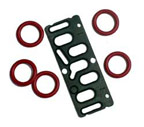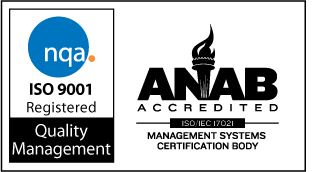
|
7108
S. Alton Way, Unit I |
(303) 758-2728
Home > Glossary of Terms > C Definitions
Glossary - C's
Calender (r) a machine with two or more parallel, counterrotating rolls with a controllable, roll-to-roll spacing, rotating at selected surface speeds and controlled temperatures, used for sheeting, laminating, skim coating (topping) and friction coating, to a controlled thickness and/or surface condition.
Capacitor (sc) a discrete device which stores electrical charge on two conductors separated by a dielectric.
Cell (r) a single small cavity surrounded partially or completely by walls.
Chalking (r) the formation of a powdery residue on the surface of a rubber, commonly resulting from surface degradation.
Chamber clean (sc) typically, a gas or plasma cleaning of the chamber to prevent the buildup of polymer or contamination on the chamber walls.
Chemical vapor deposition (CVD) (sc) a method for depositing some of the layers which function as dielectrics, conductors or semiconductors. A chemical containing atoms of the material to be deposited reacts with another chemical, liberating the desired material, which deposits on the wafer while by-products of the reaction are removed from the reaction chamber.
Chemisorption (r) a chemical adsorption process in which weak chemical bonds are formed between gas or liquid molecules and a solid surface.
Chip (sc) die or device, one of the individual integrated circuits or discrete devices on a wafer.
Coagent (r) a compounding ingredient used in small amounts to increase the cross-linking efficiency of certain no-sulfur vulcanizing systems or to modify the properties given by such systems.
Coefficient of friction (r) the force in the direction of motion required to move one surface with respect to another, divided by the force normal to the two surfaces.
Coefficient of thermal expansion (r) the increment in volume of a unit volume of material for a rise of one degree temperature at constant pressure.
Cohesive failure (r) a rupture occurring entirely within any single uniform layer of the assembly.
Cold flow (r) slow deformation, under gravitational force, at or below room temperature.
Comonomer (r) one of the two or more monomer species that polymerize to form a copolymer.
Complimentary metal oxide semiconductor (CMOS) (sc) N- and P-channel MOS transistors on the same chip.
Composite seal (r) a seal composed of two or more dissimilar materials.
Compound (r) an intimate admixture of a polymer(s) with all the materials necessary for the finished article.
Compression (r) the amount of deformation on a seal, often calculated by dividing the deformation by the original seal cross-sectional diameter.
Compression molding (r) molding process in which the material is placed directly in the mold cavity and compressed to shape by closure of the mold.
Compression set (r) the residual deformation of a material after removal of the compressive stress.
Conditioning (environmental) (r) the storage of a rubber, under specified conditions (time, temperature, humidity) prior to testing.
Conditioning (mechanical) (r) the prescribed program of deformation of a specimen prior to testing.
Conductive rubber (r) an elastomer having high conductivity. Conductor (sc) a material which is easily able to conduct electricity.
Copolymer (r) a polymer formed from two different monomers. Covalent bonding chemical bonding whereby each atom of a bound pair contributes one electron to form a pair of electrons.
Crack(s), atmospheric (r) fissure(s) originating in the surface of a rubber vulcanizate or product as a result of natural weathering.
Crack(s), ozone (r) fissure(s) originating in the surface of a rubber vulcanizate, caused by exposure to an ozone-containing environment; the fissure(s) are perpendicular to the direction of strain.
Crack(s), flex (r) fissure(s) originating in the surface of a rubber vulcanizate, resulting from cyclic deformation (usually bending).
Creep the time-dependent part of a strain resulting from stress.
Cross-link (r) chemical bond bridging one polymer chain to another.
Cross-linking agent (r) compounding material that produces cross-linking in rubber.
Crystallization, polymer (r) arrangement of previously disordered polymer segments of repeating patterns into geometric symmetry.
Cure (r) see vulcanization, the preferred term.
(sc) This term is generally associated with the semiconductor industry.(r) This term is generally associated with the rubber industry.
Next D's
Our specialty is solving sealing problems for original equipment manufacturers. We carry o-rings, seals, custom molded rubber parts, wipers, diaphrams, valves and u-cups in all types of materials including Kalrez®, FKM fluorocarbon, Simriz®, nitrile (buna-n), silicone, rubber, neoprene, polyurethane, TFE and FEP encapsulated.
We are located in the Denver Technological
Center in a suburb of Denver, Colorado
©1997-2017, Problem Solving Products, Inc.
Website Map | Privacy Statement
| Terms of Use

